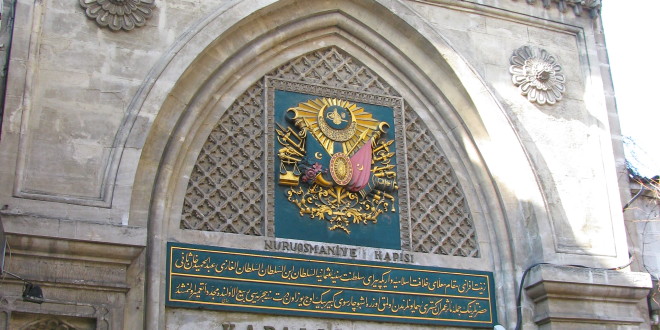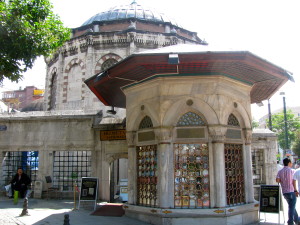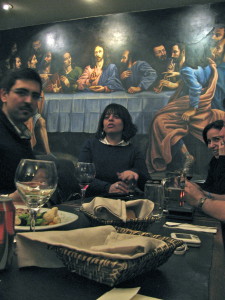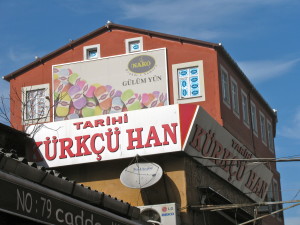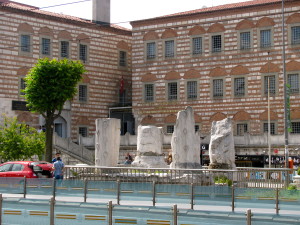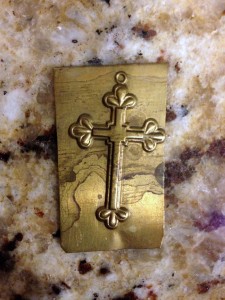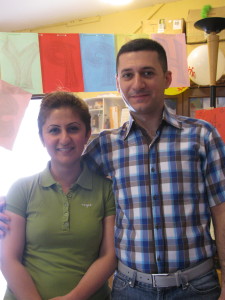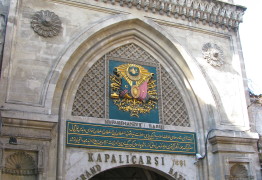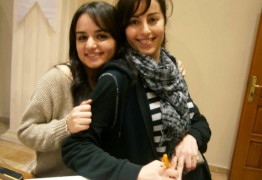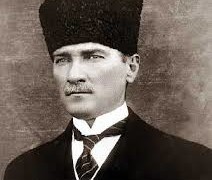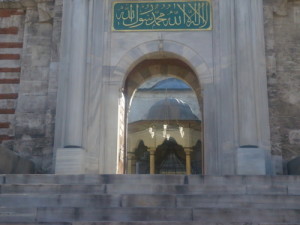
I stood in the Old City, next to the 18th century baroque Laleli mosque. Admiring its calligraphy-adorned sultan’s entrance, I looked up past bare winter branches at its minarets, shaped like tulip bulbs. Then, I turned and strolled through the Sahaflar (book exchange) Bazaar, a courtyard market dating to Byzantine times, when it was called the Khartoprateia. I ran my hand over the cool marble of a kiosk where Ottoman do-gooders would dispense tea, water, and lemonade through elaborate grillwork to passersby, helping assure their place in heaven. Then I turned and headed toward the Beyazit Hamamı, a multi-domed Turkish bath.
When I first realized I was moving to a place of deep and complex history, I had imagined myself as a kind of scholar dressed modestly and sitting alone in an Istanbul courtyard shaded by plane trees. Men wearing turbans and women in black robes passed by. My head was bent over an old book, its pages brittle and yellowed.
Now, after a year and a half in Asia Minor, I finally had the time and the confidence to dwell in that place of discovery. Never mind that I wasn’t surrounded by black robes and turbans, and that I was holding a much more modern book. I was starting to understand this profound place.
The year, 2012, had started with endings. After Angela and Greg left to return home to the States and Sankar went back to work, I wrapped up my final weeks of teaching, graded my last exams, and entered my last batch of student results into the ÖzU grading system.
Situations often improve once a decision is made to leave. Now fellow teachers, some I’d barely ever talked with, approached me, expressed disappointment that I was leaving, and asked about my plans. To my surprise, several students wrote me thank-you notes and over a dozen friended me on Facebook.
My colleagues held a dinner for me and another departing teacher at a restaurant in Kadiköy, a seaside university town on the Asia side. Snow was falling as we filed into Viktor Levi Wine House, opened nearly a hundred years earlier by a Jewish merchant from Gallipoli who introduced Aegean wines to Istanbul. On the long back wall of the restaurant was a painting of Jesus and his disciples eating together. “I know that picture,” one of my officemates exclaimed. “It’s The Last Dinner.” Yes, it was, and I would miss them all.
My first week of freedom! It felt great to wake with leisure every day and have to get to work in traffic and fill four classroom hours. But I felt unmoored. At Özyeğin, the days had gone by fast. Here, it was just 8:30 am. How would I spend the next ten hours until Sankar got home from the office?
The structured activities I could count on were few: regular exercise, once-a-week Turkish lessons with Ferda, and my monthly book club. I did have good access to books thanks to my Kindle, a gift from an early visitor, and the availability of mail-order books from Amazon, U.K. And I anticipated some busy weeks ahead. Friends and their college-aged daughter were arriving in late January, we expected another couple in mid-March, and yet another set of visitors would come in April.
We had at least six, and possibly twelve months left in Istanbul. What would this time bring? Unless I launched an effort to find new friends—and most expatriates shied away from investing time in short-termers, which I now definitely was—I’d have to depend on the people I already knew.
There was Felicia, a fortysomething former bank executive and bon vivant, who tutored English and led our book group discussions. There was Linda Caldwell, fluent in Turkish and retired in Istanbul after a foreign service career in the Middle East. And Waverley. Much more outgoing than I, she seemed to have had friends here from the day she landed. Part of that, I knew, was because with four children in the international school, she had met other expatriate parents immediately.
Waverley had created the Monday Ladies, a group of mothers of school-age children who liked to explore Istanbul. Now that I was no longer working, Waverley invited me to join. I eagerly accepted, and made plans to go exploring with the group on my first free Monday. But an hour before we were supposed to meet, Waverley called. One of her children wasn’t feel well and she had decided to stay home.
That threw me. I’d been counting on Waverley to help launch this new phase of my Turkish life. But she wasn’t an empty nester. Not even close. Three of her children were under 12. I realized I couldn’t depend on her, and that made me feel a little bereft. This might be harder than I thought.
Was I still interested in going out with the others? Waverley was asking. I hesitated; I knew none of them. But then—here we go again, I thought—a long day loomed in front of me. So I said yes. An hour later I met two delightful “Ladies” from Down Under: Rhonda, from New Zealand, and Sonny, from Australia, and we spent a pleasant day walking around the Grand Bazaar. We were even served tea by the proprietor of a marble kiosk that had been converted into an antique rug shop. Thereafter, my Mondays were taken up by this group, a varying assortment that included an Italian and a Turk, female family members who happened to be visiting Istanbul, and the occasional husband or visiting male relative upon whom we bestowed an honorary Monday Lady designation.
I had enjoyed the day at the bazaar with Rhonda and Sonny. And now, surprisingly, I found myself drawn back. Often derided as a tourist trap, the Grand Bazaar can easily confirm this impression. Vendors of cheap scarves, Chinese-made “Turkish tea sets” and cookie cutter ceramic bowls stand in front of their shops competing loudly for customers: “Excuse me, would you like to see my shop?” “I am right here!” “Hello, where are you from?” Earlier in our stay, having purchased my fill of “pashmina” shawls and fake-gem bracelets, I vowed I was finished with the place. I had managed to avoid its nearly four thousand shops for over a year. But now, I longed to comprehend this vast place, and so I was back.
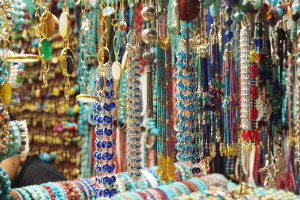
Waverley was eager to help. She had taken a guided tour of the bazaar soon after she arrived—several expatriate pros offered this service, which cost about two hundred dollars—and she reprised the tour for me, taking me down narrow corridors jammed with merchandise that opened into surprising, hidden arcades; pointing out tucked away mosques, prayer rooms, and tea kitchens that produced the magic of tiny tulip glasses of tea suddenly appearing in front of us as we shopped; and introducing me to “her” new vendors who greeted me warmly and became “my” vendors.
Around this time, a slim little book called Istanbul’s Bazaar Quarter: Backstreet Walking Tours, written by Eda Weissenbacher, a Turk of Austrian descent, and Anne Marie Mershon, came out. Mershon, to my surprise, was from Grand Marais, Minnesota and just like me, “didn’t discover Istanbul until her mid-50’s.”
The book listed four self-guided walking tours in and around the bazaar, untangling for readers the dense passages that radiated in and out of the shopping center. Armed with the book’s meticulous directions and hand-drawn maps, as well as my foundation in Turkish—I can’t overstate the importance of language in instilling confidence—I was ready to explore what had heretofore been hidden to me.
One Tuesday morning I set off by myself on “Walk A: West of the Grand Bazaar.” It started with the Taş (stone) Han, built in 1763. Hans—the word means house in Persian—were built as inns for out-of-town merchants and many now serve as retail and wholesale establishments. Most dated from the 18th century and generally included open portico courtyards surrounded by several stories of rooms also used to store goods and provide workspace. Each han, sometimes to this day, supported a particular craft or industry, such as zincirli (chains), cebeci (armor), astarcı (lining and trimming), kürkcü (fur; but now yarn: this was the Yarn Bazaar that Waverley had found right after she arrived. It dated back to the 1400s), and even çorapcı, the making and selling of socks.
From the Taş Han, Walk A took me to the Tulip Mosque where I admired the bulb-shaped minarets; then to the ornate marble sebil; and on to the elaborate old Turkish bath (just to look; I would “take the waters” later in the year). The book pointed out sights that I would otherwise have missed, for example, huge fragments of marble pediments imprinted with peacock feather eyes strewn along Ordu Caddesi, a main road. According to the guidebook, the marble was used to construct the Bull Forum in 393 AD, and then to build the Beyazit Hamam (Turkish bath) in the fifteenth century, and the remnants were left right where they fell. It would seem that no one could fail to notice huge chunks of marble in the middle of a sidewalk, but my eyes were drawn to so much else—domes, minarets, a 35-meter-tall column from the Roman era— that demanded attention.
The book steered me to carvings on the undersides of eaves; it identified sultans’ tuğras, elaborate calligraphic signatures, on doorways; it pointed out defunct marble Ottoman fountains and stairways leading down to ancient cisterns; and it made me look up at centuries-old stone birdhouses, including one with two minarets, adorning the outsides of old buildings. Because of their position between earth and heaven, birds were viewed by Ottomans as semi-sacred.
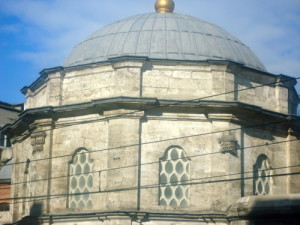
The expatriate longs for competence, and Bazaar Quarter made me feel knowledgeable in a place I’d thought was incomprehensible. It lent a historical perspective to the gold, silver, leather, and textiles in the modern Bazaar. It explained architectural features, for example buildings near the bazaar had often been started in the Christian era, with round-arched (Romanesque) windows on their first floors, but then were added to in the Ottoman era with second-story windows whose arches came to a point. And exploring the vibrant Bazaar community was a delightful counterpoint to all the quiet ruins and crumbling, lonely sites I’d seen here.
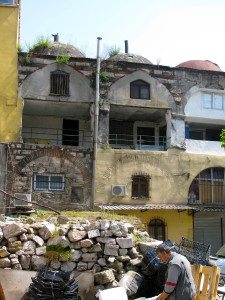
Visits to the Bazaar dovetailed nicely with my growing friendship with Linda Caldwell, the retired Foreign Service wife who had run a shop there—she was the first foreign woman to do so—for thirteen years. Sometimes she accompanied me on my jaunts, taking me not only to her favorite shops, but to meet her friends, the wholesalers that supported the shops. Inevitably, so many people rushed up to greet her that I felt like I was with a celebrity.
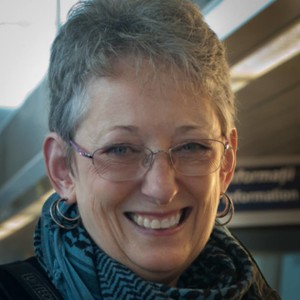
The Monday Ladies soon discovered Bazaar Quarter as well, and we set out on its walks. On Mondays, five or six of us could be seen proceeding, sometimes in single file, through the Old City, carrying identical books open to the same page, like some kind of literary cult. We were obviously enjoying ourselves—Rhonda was always teasing Waverley for wandering into each and every mosque along the way, for example—and so we attracted conviviality. Strolling through the upper level of the Sofcu (wool cloth) han, we noticed two adjacent vendors flying the flags of different Istanbul soccer teams. “Which team is better?” we asked, and that set up a round of friendly ribbing between the two shopkeepers.
Bazaar Quarter also profiles the men who work in the various hans, performing the arcane work of leather and metal pressing, spinning gold and silver threads, and molding copper and silver. We made it a point to look up these artisans and ask them to sign our books. They complied, beaming at their moment of fame. As five of us left the Zincirli Han one day, proprietor Bedros Muradyan asked us to wait and then turned back to his machine. A moment later, he presented each of us with a postage-stamp-size piece of metal imprinted with a Greek cross. It was his way of telling us he was Christian.
Monday was only one day, though, and I knew I couldn’t spend all my time exploring. I had a Turkish language lesson with Ferda late Wednesday afternoons, and on Friday afternoons Sankar and I sometimes set off on an ARIT trip, but what else could I do to keep busy? I decided to put word on the expatriate women’s listserv that I was available for volunteer work. Within a few days, I got a response from fellow book club member Madeleine Pelletier, a long-term Istanbul resident from Western Canada, who worked with Iraqi refugees. She told me these refugees were going be relocated to English-speaking countries, and that they were keen on improving their English. Could I meet with a group of them one morning each week? Sure! We decided on Thursdays.
And thus I discovered another Istanbul “world,” this one even more vibrant and fascinating than the bazaar, and one that would dominate my thoughts for the remainder of my stay. Every Thursday morning, Umit would drive me to Elmadağ (apple mountain), a shabby neighborhood west of Taksim Square, the center of the city, where protests would break out in less than a year. I would enter a run-down building that bore a metal signplate reading “Vatican Embassy,” although the Vatican had long ago vacated the premises. Inside were some old, unheated classrooms with nary a scrap of chalk at the board let alone teaching materials, a dank bathroom, and a cement courtyard that formed the Don Bosco School for Iraqi refugees. The school was part of an international network of Catholic schools founded by St. John (don) Bosco, a nineteenth century priest and educator from Turin, Italy. Overseen by one Father Rudolpho and attached to St. Esprit, Istanbul’s second largest Catholic church, the school had opened after refugees began pouring out of Iraq in 2006, enrolling several hundred students. Many had now been relocated, however, and the student population was down to just under a hundred.
I would be teaching, not the school’s students, but its four female teachers, also Iraqi refugees. I expected refugees to be sad or sullen, or perhaps even disheveled, but they were not. Young and slim, with long dark hair and dark eyes, the women dressed in stylish jeans and ballet flats (all the clothing in Iraq, they informed me, was made in Turkey), and were cheerful and optimistic, thanking me again and again for what I was about to do for them. They encompassed a range of Christian beliefs, including Roman Catholic and Protestant, and also Syriac and Chaldean variations on Orthodox Christianity.
Jian, 23, hailed from a town named Zakho that sat on Turkey’s southeastern border. She was a Kurdish Christian, two words I’d never before heard together, and she spoke Kurdish, Arabic, and Aramaic, as well as fairly good English. A brother of hers worked as a priest in France. Jian’s family had owned a liquor store in Zakho. After Saddam’s downfall, it had been destroyed by Muslims “even though they drink more than we do.” When a cousin was killed, the family decided to leave Iraq. “My whole life has been war,” Jian told me. “First the Iran-Iraq War, then the Gulf War, and now the U.S. war.” Jian was waiting to move to Sydney where, she said, her entire town, “Zakho Two,” now lived.
Samira, herself an English teacher and also slated for Sydney, wanted to boost her vocabulary, and wrote a couple of lovely short essays for me. Reeta, a computer programmer from Baghdad like Samira, was headed for El Cajón, a suburb of San Diego. Both women were in their thirties and occasionally notes of bitterness came through: their prime dating years had been wiped out because of war. Samira bemoaned the fact that Iraq used to have movie theatres “like normal countries,” but that these had now closed due to Islamization.
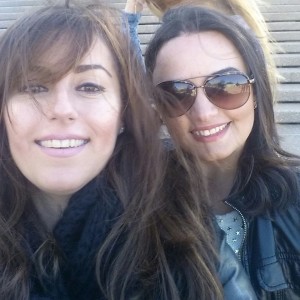
Susan had worked as a secretary for a large architectural firm in Baghdad. “I was on the phone in English all the time,” she told me. She and Reeta’s brother, Rony, were secretly dating, and in May their engagement would be announced, a love story that enchanted the hard-up community. On a sultry June afternoon, I would attend their wedding, conducted by Father Jacky from Haiti (“We had never seen a black person before,” Jian confided) with an interlude to recite the Lord’s Prayer in Arabic.
Susan told me she had seen cars flying through the air in Baghdad, and had once exited a building only moments before it exploded. She had been scheduled to settle in Detroit, but her marriage into Reeta’s family meant she would also go to El Cajón.
Producing language is the most effective way to learn it, and my students didn’t hesitate to talk about themselves and the situation in their country. One of the first things the young women told me was that “Saddam Hussein loved the Christians.” This astonished me, and they went on to say that, although Saddam was not a good person, he had allowed the country’s Christian community three days off work every Christmas. I recalled that Saddam’s foreign minister, Tariq Azia, had been a Christian.
Devout and from large families, my new students were strict in observing saint’s days, and fasted during Lent. They told me they didn’t care for Muslims, but also commented that “we act like Muslims because we are from a Muslim country.” Meaning, they went on to explain, that their families equated female chastity with family honor. Reeta mentioned a Christian honor killing in which the girl had been seeing a Muslim boy.
Here in Istanbul, their brothers forbade these young women from going out in the evenings. In fact, they had come to Turkey expecting to be mostly limited to their homes, but Father Rudolpho had called on them to teach, and their families couldn’t refuse the Church. It was an interesting role reversal—the men in their families unable to work because Turkish law prohibited refugees from working, but these women–the stereotype of the female teacher working well for them–holding challenging jobs and earning salaries, albeit tiny and surely off-the-books.
I thought about my students a great deal on the days I wasn’t with them, wondering what else I could do for them. I had Angela bring InStyle, People, and Glamour magazines for each of them in the summer when she visited. I recalled Caitlin saying that her Ozu students’ favorite television show was “How I Met Your Mother” and I began showing that each week. Occasional off-color jokes made me wince until Jian told me not to worry: they had all grown up watching Friends and other shows like CSI and Law and Order.
My students had, sadly, seen very few of Istanbul’s Christian treasures, so one Thursday Ümit—a little stiffly, as he didn’t know quite what to make of Arab Christians—and I drove them to the out-of-the-way St. Savior of Chora, an 11th century church whose walls are covered with mosaics illustrating Bible stories. They were indignant about the assumption in several of the panels that Joseph had been married before, but so grateful for the visit that they bought me a bracelet from the gift shop when I wasn’t looking.
And so the days of 2012 unfolded, a satisfying mix of exploring, reading, and teaching. The best days were Thursdays, which found the American and the Iraqis shivering in an unheated room watching sitcoms and laughing about American policemen’s fondness for donuts. I can still remember sitting in front of my new students, their shiny dark hair all that was visible as they hunched over a writing task. I was trying to pull together a few stray months; they were trying to piece together shattered lives, and sometimes as I waited for them, I struggled to hold back tears. But they were also instructing me: I was learning that no matter the setting or the availability of resources—or even the existence of a salary—I could find purpose and meaning in teaching.
